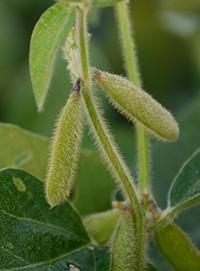 Estimating crop yield helps farmers look toward the future and make plans as harvest approaches. With corn, there are standard methods for estimating yield. But how can you estimate yield in soybeans? When soybean pods start forming, early counting for soybean yield estimates may be premature. The adaptability and resilience of soybeans also make yield estimation tricky.
Estimating crop yield helps farmers look toward the future and make plans as harvest approaches. With corn, there are standard methods for estimating yield. But how can you estimate yield in soybeans? When soybean pods start forming, early counting for soybean yield estimates may be premature. The adaptability and resilience of soybeans also make yield estimation tricky.
When Laura Lindsey talks about soybeans, and their ability to produce, she mentions 2012. The Ohio State University Extension soybean specialist recalls the dreadful drought year that decimated the state's corn crop. "Soybeans didn't care that much, and on a percentage basis yields didn't fall like corn," she recalls.
It's that resilience in the face of stress that makes soybeans a great rotational crop across the Corn Belt, but there's a challenge with the crop too: estimating yield.
"Soybeans are more plastic in their growth and most farmers have seen that," Lindsey notes. "If you have a low stand or low plant population, the plant can compensate well with more branches."
She adds that the reproductive stages of soybeans overlap. "They can flower for a couple months, and still have flowers when some pods are filling with seeds," she adds. Simply counting pods for an estimate may not yield the best results depending on the year.
And in the case of stress, perhaps a hot, dry July, you may see a yield hit. But if cooler weather and rains return in August, the plants could bounce back.
Lindsey recalls a stress study she conducted several years ago. "We weed whacked soybeans, and defoliated the plants by 50%," she recalls. "In the later vegetative stage, the plants that were defoliated yielded the same as the control plants. Soybeans recover."
Hot, dry conditions can cause blossoms to abort, leaving plants with less pods. But if rains return, those remaining pods can fill more and make bigger seeds. Timing the task of entering a field to estimate yield depends on a range of factors.
Some recommend starting estimates at R5 when the first seeds appear. "The later you go the better," Lindsey says. "Those seeds continue to fill and R7 or R8 is better. That's when pods are turning brown and the best time." She acknowledges at that point, not long before combines roll, the knowledge may have less value.
She has found that an OSU worksheet can be very accurate for some, and not for others. "We find that if the stand where we take the estimate is uneven with big plants in a lower plant population area it can throw off the estimate," she notes. "The more even or consistent the field, the better the results."
If you want to check the yields in your soybean field, there are some simple steps to follow, that Lindsey has outlined.
Checking soybean yield
1. Count plants per acre. Count the number of pod-bearing plants in 1/1,000th of an acre. In a 7.5-inch row spacing, count the number of plants in 69-feet, 8-inches of row. In a 15-inch row spacing, count the number of plants in 34-feet, 10-inches of row. And in the 30-inch row spacing, count the number of plants in 17-feet, 50-inches of row.
2. Estimate pods. Count the number of pods (containing one or more seeds) from 10 plants selected at random. Divide the total number of pods by 10 to get the average number of pods per plant.
3. Count seeds per pod. Count the number of seeds from 10 pods selected at random. Generally, the number of seeds per pod is 2.5, but this number can be less in stressful environmental conditions. Divide the total number of seeds by 10 to get the average number of seeds per pod.
4. Determine seeds per pound. To estimate seeds size, assume there are 3,000 seeds per pound. If the soybean plants experienced stress, seed size will be reduced, and it will take more seeds to make one pound. Use a seed size estimate of 3,500 seeds per pound if smaller seeds are expected because of late-season stress.
5. Put this formula to work. Using the numbers derived from each step you can estimate soybean bushels per acre: bushels per acre=[(plants/1,000th acre) x (pods/plant) x (seeds/pod)]/[(seeds/pounds) x 0.06]
This content produced by Farm Progress for Corteva Agriscience.
The More You Grow
Find expert insights on agronomics, crop protection, farm operations and more.